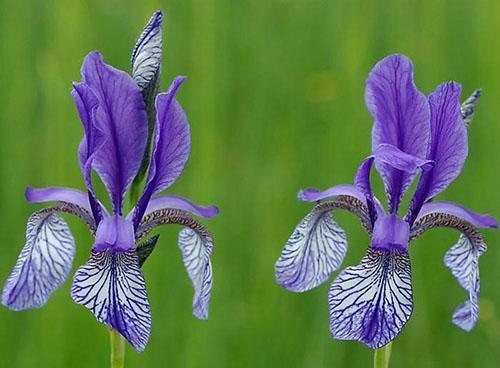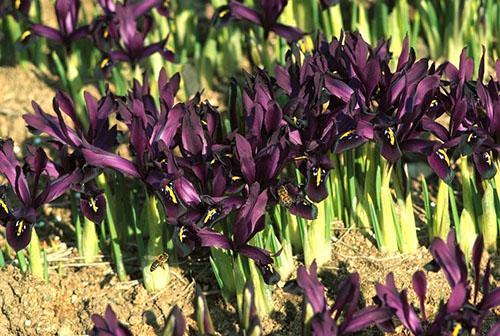Use of Siberian iris in landscape design
 Irises are a real decoration of any flower bed and flower garden. Siberian iris is distinguished by its unpretentiousness and resistance to cold weather, a fast growth rate and abundant flowering. Dense plantings of dwarf irises look beautiful along the curbs. Tall varieties grow well along fences and hedges. Several hundred varieties of Siberian irises are known, differing in the height and shape of the flower, the timing of flowering and the structure of the leaves.
Irises are a real decoration of any flower bed and flower garden. Siberian iris is distinguished by its unpretentiousness and resistance to cold weather, a fast growth rate and abundant flowering. Dense plantings of dwarf irises look beautiful along the curbs. Tall varieties grow well along fences and hedges. Several hundred varieties of Siberian irises are known, differing in the height and shape of the flower, the timing of flowering and the structure of the leaves.
Siberian iris - description and features

All irises in nature are divided into two groups.:
- Irises with a beard on the lower petals, that is, bearded.
- Irises that have no beard, that is, beardless.
Siberian iris Iris Sibirica has no beard, it has smooth silky petals, a bizarre bud, rather large. Several peduncles are formed on one stem at once - 2 and 3. The natural shade of the plant is blue-blue. Hybrid varieties have a wide variety of colors - white, pink, yellow, red, burgundy, lilac. On the petals of Siberian iris, two shades can be combined at once.
Thanks to the successful work of breeders, about 800 cultivars have been bred. Beautiful viable flowers adorn the best gardens in Europe, the Caucasus and Turkey.
Siberian iris:
- The classic flower consists of six petals, three narrow, directed upwards, and three lower ones, wider and curved towards the bottom.
- There is an eyelet near the base of the petals - a contrasting color spot, a border can pass along the petals.
- Hybrid varieties can have only wide or only narrow petals, their stems can branch.
- The difference in varieties is manifested not only in the color of the peduncles, but also in their texture. There are Siberian irises with double and smooth petals, with a corrugated and even edge.
 The main feature of Siberian iris is the strength of the stem. Even reaching 100 and 120 cm in height, the plant does not need additional support. There are medium-sized, undersized and dwarf varieties with different numbers of peduncles. Most of the varieties bloom in June, there are varieties with a late flowering period in July and August. Also, remontant varieties are distinguished, which manage to bloom twice during the warm season - in spring and autumn.
The main feature of Siberian iris is the strength of the stem. Even reaching 100 and 120 cm in height, the plant does not need additional support. There are medium-sized, undersized and dwarf varieties with different numbers of peduncles. Most of the varieties bloom in June, there are varieties with a late flowering period in July and August. Also, remontant varieties are distinguished, which manage to bloom twice during the warm season - in spring and autumn.
Siberian iris - varietal variety
Siberian irises photos of varieties and their description:
- Harpswell Haze. It has a large peduncle of a delicate lilac-blue shade with pronounced dark veins. For a long time it can grow without transplanting, a viable and unpretentious flower.

- White Swirl. White Siberian iris with a delicate golden tint, distinguished by a large peduncle - up to 15 cm and a long flowering period. A perennial bush can spread over a plot, a meter in length and width.

- Altai leader. Domestic variety, endowed with several names - iris, cockerel, bell. Each stem holds from 3 to 6 peduncles, while simultaneously blooming 2 flowers of a rich blue hue.

- Hubbard. This iris reaches an average height - from 60 to 80 cm, has a large peduncle of an unusual purple-violet hue.A distinctive feature is a yellow or white stroke at the base of the lower petals.

- Hohenflug. One of the tallest irises among Siberian ones, it can reach a height of 160 cm. It has large peduncles with wide petals of dark blue color.

Siberian iris - planting and care rules
 Planting and caring for Siberian iris is not very difficult, the plants bloom generously and beautifully in open areas. The duration of flowering depends on the variety, it can take from 2 weeks to a month. Moderate humidity is a guarantee of rapid spread and lush bushiness. For culture, a neutral soil environment is preferred.
Planting and caring for Siberian iris is not very difficult, the plants bloom generously and beautifully in open areas. The duration of flowering depends on the variety, it can take from 2 weeks to a month. Moderate humidity is a guarantee of rapid spread and lush bushiness. For culture, a neutral soil environment is preferred.
Iris siberian planting:
- spring - March and May;
- autumn - August and September.
 The rules for the autumn planting of irises - a month before the onset of stable cold weather, so that the plants can take root in the open field. Transplanting and planting Siberian irises in the spring should be carried out after frost and in well-warmed soil.
The rules for the autumn planting of irises - a month before the onset of stable cold weather, so that the plants can take root in the open field. Transplanting and planting Siberian irises in the spring should be carried out after frost and in well-warmed soil.
Irises love nutritious and loose soil, they need systematic feeding - after transplanting, at the time of bud formation and after flowering.
Rhizomes and bulbs are usually not buried, the central bud always remains on the surface. Plants need careful loosening so as not to hurt delicate roots, watering when the soil dries out, removing dead parts and weeds. With age, the flowering of the bush weakens, so it is necessary to plant the culture in new places.
Siberian iris in landscape design
 A variety of varieties of Siberian iris, with a wide variety of flower shades, stem heights and the vastness of the bush, allows it to be widely used to decorate any landscape:
A variety of varieties of Siberian iris, with a wide variety of flower shades, stem heights and the vastness of the bush, allows it to be widely used to decorate any landscape:
- In the foreground. In the first tier, it is better to plant varieties of irises with an open flower with cup-shaped petals of the brightest and most juicy shades - red, blue, yellow, orange, white.
- Behind. Tall and powerful irises make perfect backdrops for other plants and flowers.
- In the center of the flower bed. Spectacular and brightly growing irises look in the middle of an island flower bed or a round flower garden.
- Have reservoir... Iris, planted along the shore of a pond or lake, looks harmonious.

- On the lawn. Group flowers look appropriate among the green lawn, their decorative effect does not decrease at all before and after flowering.
- For rockeries. Low varieties are in demand for decorating rockeries and alpine slides... They are planted in separate specimens and in small groups.

- Difficult terrain. Rhizome irises are planted on the slopes for beauty and to prevent spillage.
- Along the tracks. The dense green of irises is ideal for garden paths, along fences and hedges.

Experienced flower growers recommend frequently dividing and replanting irises. These measures do not allow old plants to grow, help to increase their decorative qualities and extend the flowering period. Bushes can grow in one place without transplanting for 5 and 10 years in a row.
Irises are Siberian popular and multifunctional flowers. They are beautiful, unpretentious and fragrant. These plants are sung by poets, displayed by artists and adored by gardeners. There is a suitable variety for every garden. Live beauty can be brought into the house - irises stand in the cut for a long time.